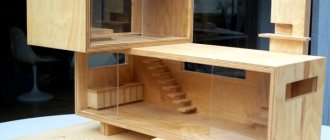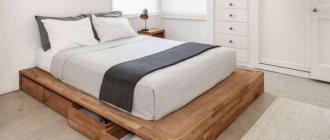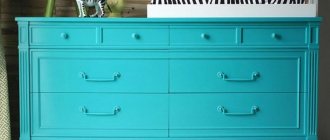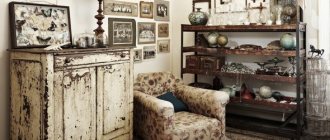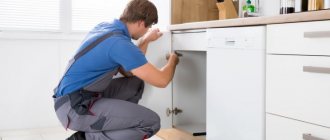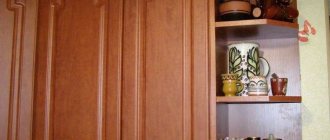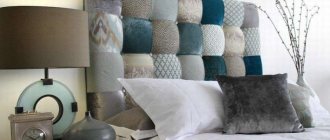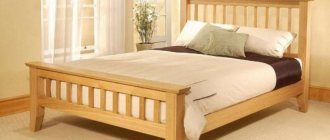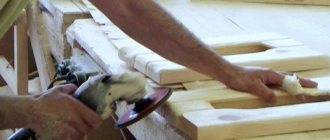Removing scratches
Scratches can appear on any household item. But on lacquered furniture they are much more noticeable. If there is information about the varnish with which the surface was coated, then it is enough to treat the scratch with the appropriate product:
- Ethyl alcohol is used for alcohol-based varnish or polish;
- Solvents 646 and 647 are well suited for nitro varnishes. You can also use acetone;
- Sandpaper is used to process surfaces coated with polyester or nitrocellulose varnish. After cleaning, you need to apply a special polishing paste and varnish again.
If the coating is unknown, then it is worth using other methods to eliminate minor scuffs and scratches on furniture. Restoration of Soviet furniture is often carried out using a touch.
In construction stores, furniture touches are presented in a large assortment; they are affordable and easy to use:
- Shake the bottle until a homogeneous mass is formed;
- Apply one coat to the scratch using a brush;
- As soon as the first coat has dried, apply the second. There can be several layers;
- Leave to dry for 10-15 minutes;
- Polish the area with a soft flannel cloth.
This completes the scratch restoration process.
Shake up the stroke
Apply the composition to the scratch with a brush
Polishing the surface
How to use wax pencils for restoration
This material is sold in all construction stores. It is easy to use and not expensive. The pencil is convenient to use when restoring carved objects, as it is easy for them to penetrate into hard-to-reach areas of the decor. Do-it-yourself furniture restoration in the Baroque style is carried out as follows:
- If the wax pencil is soft, it is enough to simply rub out the defect and polish the surface;
- If the pencil is made of hard wax, then it must be heated before applying it to the scratch.
Polish the surface with a soft cloth until it shines.
Applying a pencil
Polishing the coating
How to use furniture wax
There is another very common product - furniture wax. It can be hard or soft. The first version of the material must first be melted and the damaged areas must be filled with it. Restoration soft wax is much easier to use; it is used to rub the area with a lot of scratches. In both cases, after the wax has hardened, the surface is subjected to high-quality polishing. We also carry out restoration of furniture made from chipboard (chipboard), which has many scratches and abrasions.
Heat the wax
Apply wax to furniture
Polish the surface with a rag.
DIY mastic
If you don’t have the above materials at hand, you can make mastic for restoring a furniture wall. To do this take:
- 30 grams of turpentine;
- 20 grams of alcohol;
- 40 grams of wax;
- Petrol;
- Soft wool.
Preparing the mixture is not difficult: melt the wax in a water bath, gradually add turpentine, stirring constantly, then pour alcohol into the container. Take a woolen rag, wet it with gasoline, dip it in the mixture and rub it over the damaged surface until it shines. The job of removing scratches from a wooden surface is not difficult. Now let's look at how to restore furniture with more serious damage.
Preparing materials
Apply gasoline to the coating
Cover the surface with wax
Rules for caring for plastic kitchens
A plastic kitchen is a practical, inexpensive, and also convenient option. Modern technology has now reached its limit, and plastic kitchens are now of the highest quality. Plastic is now resistant to high temperatures; neither moisture nor steam will harm it.
Caring for a plastic kitchen won’t be particularly difficult, but it’s better to do it regularly, avoiding too much contamination. You can wash the plastic with a damp cloth, soapy water or a gentle cleaner. Afterwards, wipe dry with a towel or rag. It is better not to use brushes with hard teeth, as they can scratch the surface of the kitchen, and restoration will be very difficult.
A plastic kitchen should be constantly dry, because constant contact with water has a very bad effect on plastic.
It is also better not to wipe with alcohol, after which the plastic surface will become dull and appear dusty.
What products should not be used to clean a plastic kitchen?
There are a lot of different products for cleaning plastic surfaces on store shelves. But sometimes it is worth making sure that such substances do not contain certain impurities:
- Solvents
- Acetone
- Chlorine
- Acid containing ingredients
These ingredients can corrode the plastic surface of your kitchen, so be careful.
How to care for a wooden kitchen
A wooden kitchen is not as rare as a glossy or plastic one. Many housewives have already gotten used to it and know all the secrets of caring for such a set. They know all the pros and cons of this furniture.
Restoring chips and deep cracks
Chips and deep cracks on the surface of furniture are considered quite serious damage, and they are much more difficult to eliminate. If you are not confident in the quality of this work, contact a professional. Furniture restoration by a private craftsman will not be cheap, but it will be done with high quality and with a guarantee. If you decide to do it yourself, pay attention to what tools and materials will be needed:
- Stain of the desired color;
- White spirit, to dissolve the varnish coating;
- Special primer for wood;
- Putty mixture for wood;
- Sandpaper of different fractions from 100 to 3000;
- Painting tape;
- Brushes and rollers.
The work execution algorithm looks like this:
- In case of incomplete restoration, the surface on which there is no damage is covered with tape;
- The damaged area is treated with white spirit to remove the old varnish;
- Apply primer to wood and leave until completely dry;
- The chip is puttied with a special compound so that a small bump appears on the surface;
- As soon as the putty is completely dry, it is sanded;
- Wipe the area with a damp suede cloth and apply stain of the desired color.
The work must be carried out carefully so that the stain does not get on the undamaged area, otherwise the wood will darken and a complete restoration will have to be carried out. Once the stain has dried, you can varnish the repaired area. Furniture restoration varnish is applied with a brush, if the area is small, or with a roller.
It is necessary to cover the surface in several layers, with each subsequent layer being sanded with 800 grit sandpaper after drying. The last layer must be polished with a special polish.
If you don’t know how to carry out restoration correctly, you can purchase special books that describe the entire process in detail. You can also take advantage of master classes from the Internet.
Treat with white alcohol
Apply primer
Apply putty inside the cracks
Sanding
Cover the coating with stain
What products are not recommended for use?
To eliminate the risk of scratches, fading of the coating, color fading and other troubles, when caring for glossy furniture you should not use aggressive compounds and materials, including:
- abrasives - powders, brushes, hard sponges;
- solvents, for example, acetone;
- alcohol;
- chlorine-containing substances;
- nitroglycerine.
Powder and caustic compounds are not recommended for cleaning glossy kitchens.
Also, any caustic compounds that can disturb the glossy layer, for example, ammonia, citric acid solution, vinegar, are not recommended.
What to do if the veneer delaminates
Veneered products require a special approach. The means and tools for restoring furniture are the same as for restoring wooden products, but the methods for eliminating defects are different:
- Veneer restoration begins with an inspection of the object. If swelling appears on the surface, then you need to take a syringe with a thick needle into which to draw PVA construction glue. Carefully pierce the swelling with a needle and squeeze the glue inside. Place a piece of clean cloth on the area and place a weight. If the veneer sticks unevenly, this area should be heated with an iron or a bag of hot salt;
- A small peeled piece of veneer should not be cut straight with a knife, it is better to break it off. The uneven edges of the crease are much easier to join. Then the fragment should be cleaned of the old glue, a new layer of adhesive should be applied and the part should be applied to the fracture site. Place a rag and place a weight;
- If repairing scratches is required, it is carried out in the same way as when restoring wooden furniture: small ones are covered with a furniture pencil, deep ones are filled with wax. After drying, the restoration wax is sanded, polished and varnished.
Restoring luxury furniture yourself requires special care and patience. There is no need to rush - apply the compound, wait until it dries, sand and apply again, and so on several times. The methods vary; in some situations you have to use several methods to achieve the desired effect.
Inspecting the coatings
We tear off the damaged section of veneer
Repairing cracks
Features of a glossy kitchen
The glossy facade looks presentable and stylish, allowing you to create luxurious interiors even in a compact kitchen. Due to the reflective effect of the coating, a visual expansion of the area is provided, creating a feeling of freedom of space and an abundance of light.
However, the surface gets dirty easily and requires proper care. If we wash a glossy kitchen correctly, the risk of streaks is eliminated and the shine is maintained. Otherwise, it is difficult to avoid incidents in the form of surface tarnishing, whitish spots and other unpleasant consequences.
Complete paint refurbishment
If using putty and varnish it is not possible to recreate the former beauty of the furniture, you need to restore wooden or complete restoration of Soviet furniture yourself. The work is carried out in stages, the sequence of which must be strictly observed.
Cleaning the surface of old coating
Before you begin removing furniture varnish or paint from the surface of the furniture, you need to purchase a special remover. Restoring Italian furniture made from valuable wood is a very responsible task, so emulsion-based removers are used. This material is non-toxic and harm to wood is minimal. It is worth noting that the fire rate of these washes tends to zero, which is a plus if the work is carried out in an apartment. So modern furniture restorers recommend using this particular material.
Working with washes:
- As soon as the remover hits the varnish coating, the corrosion process begins. You need to apply the material using a special flute brush and wait. Polyester varnishes will come off after 2-3 hours, alcohol compositions in 30 minutes;
- Before applying the remover, the polyester coating must be sanded with coarse sandpaper so that the composition penetrates as deeply as possible;
- After applying the material, all furniture must be well wrapped in paraffin-soaked paper and secured with string or twine;
- Remains of old paint or varnish can be removed after the time indicated on the package with the remover. A simple spatula can be used for cleaning;
- Next, the entire surface is degreased with a solvent.
After these steps, the furniture is left to dry for several hours. Then you should walk over it with sandpaper along the fibers and wipe off dust with a damp rag.
Sand the surface
Apply the remover
Covering furniture with paraffin paper
Removing old paint
Degrease the surface
What material to use for varnishing
When choosing a furniture varnishing product, you need to rely on the advice of professionals, for example:
- Water-based varnishes are used for restoring furniture at home in children's rooms. They have no unpleasant odor, dry quickly, and do not cause allergic reactions. There is a small minus - after drying they become matte, which some people don’t like;
- Alkyd varnishes are recommended for use by people who have no experience in varnishing surfaces. They are easy to use and apply smoothly the first time. Even if there was a leak during application, it is easy to wash off;
- Polyurethane compounds are the most difficult to apply: firstly, they require special equipment to apply them, and secondly, they have an unpleasant odor. But it is worth noting that such a coating will last much longer than all of the above materials;
- Furniture restoration (the master class can be viewed on our resource) is carried out using furniture oils. A tampon is used to apply the composition.
The surface to be varnished must be smooth. Before applying furniture varnish, buy two soft brushes. After applying the first layer of varnish, take a new tool.
Restoration of cabinet furniture at home can be done independently, only if a strict sequence in the process is observed:
- Remove the old topcoat layer;
- Clean the surface;
- Apply primer;
- Repair chips and scratches with putty;
- Sand after drying;
- Apply stain;
- Apply furniture varnish.
This plan will help you avoid making mistakes when working on the restoration of wooden interior items.
Removing old paint and cleaning
We prime
We putty the chips
Sanding the coating
Cover with stain
Applying varnish
How to clean the kitchen from grease in five minutes
The kitchen is a family gathering place. Any family will gather for dinner in the evening, talking about their adventures of the day.
Don't be afraid of greasy stains in the kitchen. You cook a lot, so contamination is inevitable. Any kitchen surface will be dirty, just like kitchen towels, tablecloths and other kitchen utensils.
How to get rid of eternal dirt and grease in the kitchen without spending a lot of time, effort and money on cleaning:
- The most necessary item in the kitchen is paper towels. They can be used to wipe your hands while cooking and eating, as well as a surface that has just become dirty. To do this, lightly moisten the towel and wipe.
- If you accidentally drop grease, do not immediately use all household chemicals. First try moistening the surface with warm water and let it oxidize. After oxidation, wipe the area with a paper towel.
- Sometimes you just can't do without cleaning products. But before you buy them, make sure they are suitable for your surface. A good product will remove fat without problems.
- Soda removes difficult stains well. It must be mixed with water until it becomes mushy. Next, apply to the area where the greasy stains remain and wait about ten minutes. Then remove using the same paper towels.
- Vinegar will also help remove grease stains. Mix one-fourth vinegar with water and add lemon juice for flavor. Apply to the surface for a while, then wipe off.
- Carry out wet cleaning regularly, this will prevent grease from drying on the surface.
Technology of working with upholstered furniture
Restoration of upholstered furniture is carried out according to the following algorithm:
- Perform complete disassembly;
- Wooden elements should be sanded well along the grain and wiped with a soft damp cloth to remove dust from the product;
- Cover the parts with wood primer and let dry thoroughly;
- For painting, it is better to use aerosol paints, as they go on much smoother. In this case, three layers of paint will be enough. As soon as the paint has dried, a layer of protective furniture varnish is applied to the surface;
- Remove the upholstery and take out the filling. To choose the method by which the restoration of upholstered furniture will be carried out, you need to know the features of the updated product. For example, if we take into account the restoration of chairs, then it is enough to stretch new fabric on the seat. In the photo you can see the product before and after restoration. If a chair or sofa is being restored, then you will have to not only change the upholstery, but also the filling;
- Using the old pattern, cut out the filler. You can use sheet foam rubber, which is available in a large assortment in stores;
- Cut out the fabric elements. To do this, lay out the old upholstery parts on a new canvas and make the corresponding elements;
- Stick the filler onto interior items. To do this, you can use PVA construction glue;
- Lay the sheathing and, using a construction or furniture stapler, secure it to the back of the product. The fabric should be of medium tension, and the staples should be located every 3-5 cm from each other;
- The last stage of work will be assembling the furniture.
It is worth noting that textile workers use a special restoration kit, which contains everything necessary for high-quality reupholstery of upholstered furniture. As you can see, there is nothing difficult in restoring upholstered furniture with your own hands. If you do everything correctly, the result can be a product with an interesting design that will delight you for many years.
Unusual solutions
The imagination of home craftsmen literally has no limits, so completely unexpected things can serve as materials for kitchen renovation.
- Photo wallpaper is a material that is in no way inferior to PVC film in terms of density and strength. It is fixed to the surface of chipboard, MDF and even plastic with liquid nails. Photo wallpapers are cut to the size of the facades and pasted in the most usual way. After the glue has dried, the products must be opened with varnish. If desired, you can order photo wallpapers with images from your personal archive.
- Tile finishing. As a rule, walls are decorated with ceramics. However, nothing prevents you from using this beautiful material as decoration for a flat or paneled facade. The tiles are cut and fixed using the same liquid nails.
- An even more interesting, but also labor-intensive option is porcelain mosaic. There are not enough broken dishes from one apartment for this, so you will have to get the fragments somewhere: if you negotiate with the nearest cafes and restaurants, you will get the material quite quickly. The fragments are sorted by color, used to form a pattern or simply a color gradient and glued to the surface of the facade. The gaps between the fragments are sealed with grout.
Restoring kitchen furniture should first of all restore functionality. However, the process is creative and exciting, so that as a result the kitchen can completely change its appearance.

